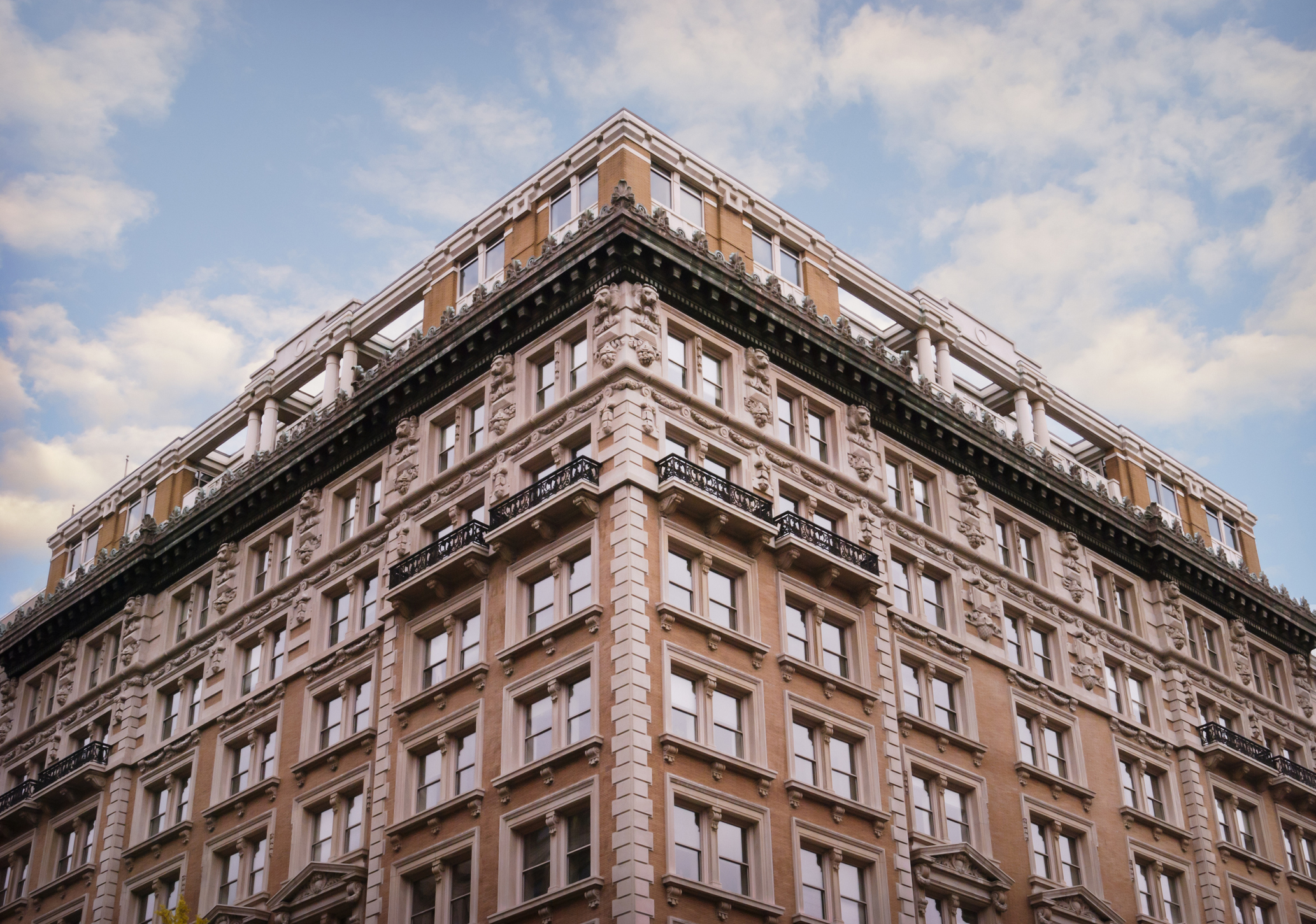
What is Pre-War Architecture? The Definition, Pros, and Cons

By Lilly Milman
Feb 19, 2024
If you’ve ever looked for an apartment in New York City, then you likely have bumped into the terms “pre-war” and “post-war.” The two describe distinct architectural styles shaped by changing consumer needs before and after World War II. But while the former is often coveted for its increasing rarity, that doesn’t mean it isn’t without its drawbacks.
In this article, we’ll go over what pre-war architecture is and its history, how it differs from post-war architecture, what the pros and cons are of living in a pre-war apartment, and tips for how you can find or identify a pre-war apartment.
What is a Pre-War Apartment?
In the most basic terms, a pre-war apartment is one that was built between the years of 1900 and 1939. The term “pre-war” refers to the period before World War II, though architectural purists do not include 19th century architecture when using the term “pre-war.” Buildings erected before the year 1900 will have different features than pre-war homes, and the pre-1900 period is more defined by the Victorian and Colonial styles of architecture.
What is the history of pre-war apartments?
Pre-war architecture arose from the mass movement of US residents from farms and rural settings into cities. Apartment buildings started to crop up in major cities like Philadelphia, New York, Boston, and Chicago, and the units were built on the idea that it’s possible to have all the charm and comfort of home within the walls of an apartment. Prior to then, apartments were considered uncomfortable and not in vogue.
At the time that pre-war architecture was flourishing, materials were expensive and labor was less so — meaning that more time was spent on crafting intricate details inside individual apartments.
What do pre-war apartments look like?
Pre-war apartments are known for their artistic finishes, high ceilings, spacious layouts (often including grand foyers), and attention to detail. A few common characteristics of a pre-war apartment are:
- Crown moldings
- Pillars
- Built-in bookcases
- Fireplaces
- Hardwood floors, often in a parquet or herringbone pattern
- Archways
- Solid wood doors
- 11-foot ceilings
- Brass and wooden finishes
What is the difference between pre-war and post-war architecture?
Once soldiers began returning from war, the need for housing in cities increased even more — and the more utilitarian post-war architecture took over. New construction buildings tend to have lower ceilings, less ornamentation, and more rectangular floorplans. However, what they lose in architectural charm, they make up for in functionality. Post-war buildings tend to be better equipped for modern amenities like gyms, central air conditioning and in-unit laundry, as well as open floor plans and larger kitchens.
Pre-War Apartments: Pros & Cons
Pre-war apartments are not as common as post-war apartments, and their exclusivity and rare architectural features make them a hot commodity in major urban real estate markets. That doesn’t mean they’re the perfect fit for just anyone, though. To really love a pre-war apartment, you will need to appreciate the architecture enough to make concessions on some amenities, for example. We outline the rest of the pros and cons of going pre-war for your apartment below.
Pros
- More spacious. Because efficiency was less important when pre-war apartment buildings were being created, they often have larger floorplans with more separate bedrooms than a post-war apartment would have. They also tend to have much higher ceilings and a lot of large windows, so they feel sunny and spacious. Even better, they tend to have a lot of closet space.
- Formal dining rooms. If you’re a fan of hosting a dinner party, then you’ll be in luck in a pre-war apartment. They tend to have more sectioned off spaces like formal dining rooms and foyers, which makes hosting larger groups easier. No more eating on the couch in the living room!
- Ornamental design. Known for the craftsmanship that went into their creation, pre-war apartments will have architectural details sure to please any art buffs and renters who wants a little charm in their home. Think: crown moldings, hand-painted tile work, and ornate fireplaces. They buildings themselves will also likely have large, decorative lobbies.
- Thicker walls and floors. Pre-war architecture is more likely to have plaster walls and concrete floors, which will lead to less noise traveling between units. So, if you live in a pre-war building, you’ll likely have less of a need for soundproofing.
Cons
- Smaller kitchens. When pre-war apartments were being built, it was more common for their inhabitants to hire help to work in their kitchens. For this reason, many pre-war kitchens tend to be cramped and closed off from the rest of the apartment — a less desirable set-up than the large open kitchens that are more common today.
- Less in-unit amenities. Pre-war apartments are (unsurprisingly) located in older buildings. That means that they’re less equipped for modern amenities, like in-unit air conditioning and laundry. Heating a pre-war apartment may also be more difficult and more expensive, depending on what kind of heating system the building uses.
- More expensive. Though this will depend on the specific building and apartment you are looking at, you’ll likely see that pre-war units are more expensive than post-war units — despite having less amenities. That’s because pre-war apartments are coveted for their exclusivity, their quality construction, and their size, among other factors.
- Less open floorplans. If a modern open floorplan is what you’re looking for, you’ll struggle to find it in a pre-war building. Pre-war architecture in general favored more deliberately sectioned off, separate floorplans — which to some can feel stuffy and overly traditional. However, note that some pre-war apartments have undergone renovations to create more open floor plans.
How to Find a Pre-War Apartment
If you have your heart set on a pre-war apartment, just know that you’ll only be able to find pre-war buildings in certain areas. For example, if you are looking for a pre-war NYC apartment, you’ll have the most luck if you stick to Manhattan, Queens, and the Bronx. There are some pre-war buildings in Brooklyn, but not as many. Neighborhoods with a higher concentration of pre-war buildings include the Upper West Side and the West Village. If you’re looking for a pre-war apartment in Boston, check out the Back Bay neighborhood, which will be home to some of the city’s oldest apartment buildings.
In general, when looking for a pre-war apartment, look into older neighborhoods that have more apartment buildings rather than townhouses, single-family homes, or duplexes and triplexes. When scanning apartment listings, keep an eye out for the characteristics that we named above.
Top cities
Atlanta Apartments
1,825 apartments starting at $630/month
Austin Apartments
6,133 apartments starting at $600/month
Baltimore Apartments
1,423 apartments starting at $640/month
Boston Apartments
5,609 apartments starting at $425/month
Charlotte Apartments
2,980 apartments starting at $570/month
Chicago Apartments
5,458 apartments starting at $400/month
Dallas Apartments
5,455 apartments starting at $625/month
Fort Worth Apartments
2,695 apartments starting at $695/month
Houston Apartments
5,813 apartments starting at $450/month
Las Vegas Apartments
1,016 apartments starting at $795/month
Los Angeles Apartments
12,712 apartments starting at $750/month
Miami Apartments
702 apartments starting at $1,200/month
Milwaukee Apartments
1,106 apartments starting at $475/month
New York Apartments
8,874 apartments starting at $600/month
Oakland Apartments
983 apartments starting at $850/month
Orlando Apartments
877 apartments starting at $895/month
Philadelphia Apartments
3,614 apartments starting at $500/month
Phoenix Apartments
3,461 apartments starting at $592/month
Pittsburgh Apartments
1,382 apartments starting at $590/month
Portland Apartments
2,260 apartments starting at $575/month
Raleigh Apartments
1,471 apartments starting at $550/month
San Antonio Apartments
3,372 apartments starting at $525/month
San Diego Apartments
2,860 apartments starting at $650/month
San Francisco Apartments
664 apartments starting at $500/month
San Jose Apartments
516 apartments starting at $1,000/month
Seattle Apartments
3,520 apartments starting at $452/month
Tampa Apartments
776 apartments starting at $808/month
Washington DC Apartments
2,256 apartments starting at $910/month


